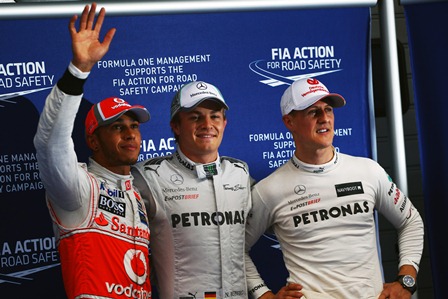Lewis Hamilton parks his McLaren MP4-27 on the approach to Turn 4 at the Marina Bay Street Circuit under the lights in Singapore. He steps from his stricken McLaren and walks away into the darkness, taking one last prophetic look back before ambling away from the circuit. The next time he steps into a McLaren cockpit, he’s been confirmed as a Mercedes driver in 2013.
Hamilton signed a five year contract with McLaren at the end of his magnificent 2007 season, during which he came tantalisingly close to destroying the myth that a rookie is unable to fight for the ultimate honour, a season in which he took on Fernando Alonso and, in a hostile atmosphere, won. 2008 delivered Hamilton his maiden world title but from then on, the anticipated Hamilton-McLaren era never arrived. The 2009 regulations saw McLaren slip from title contenders to midfield fodders, although Hamilton managed to win a couple of races when the car came good. A blip? That’s what was hoped for, but Hamilton’s best championship positions were achieved in his first two years. McLaren failed to deliver a car capable of winning the title in 2010 and 2011, with the latter being Hamilton’s annus horribilis as the realisation that Vettel was stealing his glory hit home. Hamilton refreshed ahead of 2012 and the signs were promising. Red Bull was on the backfoot. The MP4-27 was quick. Hamilton finally realised his talent in 2012 and should have been in the fight for the title. But he lost a potential four wins and a bucketful of points through issues that weren’t his fault. Title number two goes begging again. The reality is that, after an emotional farewell in Brazil last year, Hamilton begins his seventh season with a different team, the potential of the Hamilton-McLaren relationship unrealised. McLaren must be wondering how they lost the fastest driver in Formula One, but conversely, has Hamilton thrown away potentially the best years of his career?
While McLaren was winning races at the end of 2012, Mercedes’s season went into free-fall. Schumacher’s seventh place in Brazil was all they had to show for their efforts in the final six races, beating Sauber in the Constructors Championship by a measly twelve points. So the question was obvious. Why did Lewis throw away a top seat to move to the fifth best team, and a distant fifth at that? The technical regulations for 2013 are very similar to 2012. Barring a 2008/9 style rules overhaul, you don't find a couple of seconds in a couple of months.
There are reasons to be hopeful, even for 2013. Many have been quick to assert with full confidence that Lewis Hamilton will not pick up a trophy until 2014, let alone visit the top step of the podium. Lest we forget that Mercedes claimed two pole positions, a win and a further two podiums in 2012. They should have scored more points but they were lost through unreliability and driver errors. The Double DRS, which was initially their trump card, turned out to be a bit of an Achilles’ heel, as explained by team principal Ross Brawn. "One of the conclusions we have reached is that the double DRS was a valid concept, but it slowed us down on other things", he told Italian publication Autosprint at the end of 2012. While Red Bull’s Double DRS stalled the rear wing, the W03 focused on the front wing, resulting in understeer. Brawn also admitted that the W03’s narrow tyre range – which suited the car perfectly in China but was suited to neither the cool Malaysian conditions nor the hot Bahrain weather – tricked the team. "In the races where the tyre factor was decisive, we had more difficulties. So, we thought that was a key point to work on over the second half." Mercedes has struggled for tyre longevity throughout Pirelli's time in Formula One, particularly at the back of the car. This is a key area that has to be worked on ahead of 2013.
Once it was clear that Hamilton was going to put pen to paper, Brawn admitted that 2012 was sacrificed for the good of 2013. "We have invested heavily in the future, in the meantime paying heavily for it in the second half of the season, where a few tenths make a big difference." Changes have been taking place at Mercedes’s base in Brackley. The team hired Bob Bell, Aldo Costa and Geoff Willis towards the end of 2011, with Brawn emphasising that their contribution would not be felt until 2013. A significant technological advancement has also taken place, as the windtunnel has been upgraded from 50% to 60% which should, in theory, provide the team with greater data accuracy. It’s a crucial piece of equipment, as demonstrated by Ferrari’s windtunnel struggles and their repeated use of Toyota’s facility in Cologne. It isn't a case of switching the plug on and getting it going, but it will affect Mercedes's results. Ferrari's early season problems in 2012 - and McLaren's in 2009 - were attributed to a lack of correlation between windtunnel and on-track data. Norbert Haug has paid the price for poor results and if they cannot be improved, how long will the men in suits remain satisfied? As Jackie Stewart explained at last week’s Autosport Show, "If for whatever reason, they do not win, it's a five-minute board meeting decision with a bunch of people on the board who are not passionate about motorsport. They like the results if they win. If they don't win, it's yesterday. And that takes five minutes." Stewart may seem to be painting an overly negative view, but since the turn of the century Jaguar, Toyota, Honda and BMW all unceremoniously disposed of their F1 teams after poor results. They''re not in the sport for the love of it. And they're not bankrolling the team and its driver to pick up the occasional podium.
It’s clear that Hamilton wanted to move away from McLaren, to grow up and mature in a different environment. Less PR days, more control, the ability for Simon Fuller and co to build up Brand Hamilton. Time for Lewis to be his own man. But on track, the Lewis factor may also help Mercedes.
Is Hamilton the best F1 driver? Fernando Alonso and Sebastian Vettel would have something to say about that. But across a single lap, he’s certainly one of the finest. Despite winning in 2012, Nico Rosberg’s season was rather unimpressive. Michael Schumacher was certainly lacking the final few tenths he harboured in his heyday. No-one can be sure how much time Lewis can bring to Mercedes, but having a quick driver could make that difference of a few tenths. If we were to judge the Ferrari F2012, McLaren MP4-27, Red Bull RB8 and Lotus E20 from the results of Felipe Massa, Jenson Button, Mark Webber and Romain Grosjean respectively, it would put a different perspective on the 2012 machines. Hamilton has that ability to drag every last tenth from a car that only a few drivers in each generation possess.
Splitting development between 2013 and 2014 could be a challenge for the team, for they don’t have the numbers of Red Bull, Ferrari and McLaren. If the W04 turns out to be a disappointment, Hamilton may have to bite the bullet on the assumption that the Brackley based teams can repeat their 2009 heroics. 2014 is the main hope, as the new engine regulations mean that aerodynamics will become less crucial. That new V6 engine might be Mercedes’s saviour. For Hamilton, it’s undoubtedly the biggest gamble of his career. He’s left a stable environment and the fastest car for the unknown. His stock may rise – look at how Alonso’s image has improved since 2008, despite his title-less years – and even if the collaboration turns out to be a complete failure, he should still have plenty of suitors and will be just the other side of thirty.
Hamilton can’t improve a team single-handedly. In a sport where one of Red Bull, Ferrari, McLaren, Lotus or Mercedes has to finish in fifth place, each team has an army of people working hard to achieve the best results possible. But the acquisition of Hamilton is a signal of intent from a team that has been meandering aimlessly for a few seasons. Whatever happens, it’ll be fascinating to watch how the relationship progresses. It’ll define the legacies of both driver and team.



























